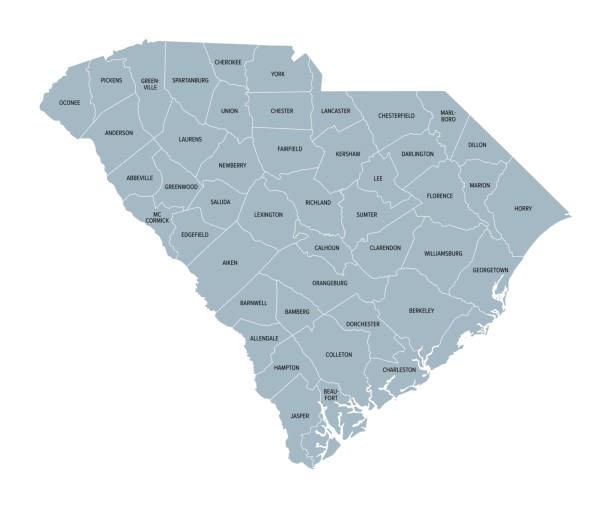Opioid Use Disorder Treatment Cascade of Care
South Carolina Opioid Treatment Data Dashboard
This data dashboard, created by researchers at the University of South Carolina as part of their work with the Center of Excellence, uses  2021 Medicaid data to show the rates of opioid use disorder diagnosis, treatment, and retention in treatment across the state. Over time, we'll be adding data on the same rates for people who are uninsured. Use the dashboard to easily understand treatment system usage in South Carolina, how data differs across the state, and where we may have opportunities for improvement. Click the icon on the left to be taken directly to the dashboard.
2021 Medicaid data to show the rates of opioid use disorder diagnosis, treatment, and retention in treatment across the state. Over time, we'll be adding data on the same rates for people who are uninsured. Use the dashboard to easily understand treatment system usage in South Carolina, how data differs across the state, and where we may have opportunities for improvement. Click the icon on the left to be taken directly to the dashboard.
South Carolina County and Regional Profiles
These county-level profiles provide information regarding rates of opioid use disorder diagnosis, treatment initiation, and treatment retention among Medicaid-enrolled South Carolina residents. Local decision-makers can use these profiles to identify where resources, including abatement dollars, can be allocated to maximize treatment outcomes and achieve healthier communities.
Our approach follows the Opioid Cascade of Care framework, which has been recognized by the National Institutes of Health and the Centers for Disease Control and Prevention. The Cascade of Care is consistent with the medication first model, which recommends that people with opioid use disorder receive medication as quickly as possible and should not be delayed until psychosocial assessment and counseling is initiated. The Cascade of Care framework helps track how many people are successfully engaging in treatment for opioid use disorder by breaking it into stages like diagnosis, engagement, and recovery. This structure makes it easier to identify where people may be falling through the cracks of our systems of care and helps target resources to where they're most needed. The Cascade of Care is crucial for optimizing treatment effectiveness, guiding resource allocation, and ensuring a comprehensive approach to treatment.
Explore each profile to gather information about opioid use disorder diagnosis and treatment receipt in South Carolina counties and regions on our Data Dashboard.
Approximately six people die every day from drug overdoses in South Carolina. In 2022 alone, over 2,200[1] South Carolinians died from drug overdose,[2] making our state the 11th most deadly state per capita for drug overdoses in the nation.[3] Despite recent reductions in overdose fatalities, drug overdose has become the leading cause of death among residents under 45 years age.[4] The ongoing crisis and loss of life is devastating to individuals, families, and communities across the state.
Most drug overdose deaths involve opioids, [5] a class of drugs that are commonly used to reduce pain, but which carry high risk of addiction and can be deadly when misused. This class of drugs includes pain medications available legally by prescription, such as oxycodone, hydrocodone, codeine, morphine, methadone, and synthetic opioids such as fentanyl, as well as illicit formulations such as heroin and illicitly manufactured fentanyl.
Treating opioid use disorder with medication can lower the chances of return to use, overdose, and death.[6] Indeed, untreated opioid use disorder doubles the risk of death by any cause.[7] Yet surprisingly, less than 10% of Americans with an active opioid addiction receive any treatment for their condition.[8]
The American Society of Addiction Medicine recommends a full continuum of care for individuals with opioid use disorder that includes outpatient services, intensive outpatient programs, residential treatment, inpatient hospitalization and crisis care, and opioid use disorder treatment medications approved by the U.S. Food and Drug Administration, including methadone, buprenorphine, and extended-release naltrexone.7 Receipt of medications for opioid use disorder treatment should not be contingent on whether an individual is engaged in psychosocial treatment. Treating opioid use disorder with medication is evidence-based; those with opioid use disorder should begin medication immediately with or without concurrent psychosocial treatment.
[1] https://www.cdc.gov/nchs/nvss/vsrr/drug-overdose-data.htm
[2] https://justplainkillers.com/wp-content/uploads/2023/06/Drug-Overdose-Report-2021-Final_updt3.pdf
[3] https://www.cdc.gov/nchs/pressroom/sosmap/drug_poisoning_mortality/drug_poisoning.htm
[4] South Carolina Department of Health and Environmental Control. (2017). 10 leading causes of death by age group, South Carolina 2011-2015 (number of deaths). https://scdhec.gov/sites/default/files/Library/CR-011788.pdf
[5] https://scdhec.gov/news-releases/drug-overdose-deaths-south-carolina-continue-alarming-increase-dhec-daodas-share
[6] Blanco, C., & Volkow, N. D. (2019). Management of opioid use disorder in the USA: present status and future directions. Lancet (London, England), 393 (10182), 1760–1772. https://doi.org/10.1016/S0140-6736(18)33078-2
[7] Bahji, A., Cheng, B., Gray, S., & Stuart, H. (2020). Mortality among people with opioid use disorder: a systematic review and meta-analysis. Journal of Addiction Medicine, 14(4), e118- e132. https://doi.org/10.1097/ADM.0000000000000606
[8] https://www.samhsa.gov/data/data-we-collect/nsduh-national-survey-drug-use-and-health
It is crucial to have up-to-date information regarding how many South Carolina residents with opioid use disorder have been diagnosed and treated. The Cascade of Care framework is essential for measuring opioid use disorder identification and treatment because it offers a structured approach to understanding the treatment process. It divides care into distinct stages—such as diagnosis, engagement, retention, and recovery—making it easier to identify where individuals may be falling out of the system. This helps pinpoint gaps in care and design targeted interventions to improve treatment outcomes. Additionally, the framework supports effective resource allocation by highlighting where resources are needed most. It also enables data-driven decision-making and ensures a comprehensive, patient-centered approach to managing opioid use disorder. The National Institutes of Health and the Centers for Disease Control and Prevention have promoted the Cascade of Care as an important public health framework for organizing, monitoring, and improving effectiveness of evidence-based care and achieving health milestones.
Resources for understanding the Cascade of Care include:
- Why States Should Measure Opioid Use Disorder Treatment to Improve Outcomes
- Use a Cascade of Care Approach to Evaluate Gaps in the Opioid Use Disorder Treatment Pipeline
- State Measures for Improving Opioid Use Disorder Treatment Implementation Toolkit
- How Clinicians Can Achieve the Care Cascade
- Understand the National Landscape of Treatment for Opioid Use Disorder
The data included in these profiles comes from South Carolina’s Medicaid enrollees in 2021. It is important to understand the treatment experiences of South Carolina residents enrolled in Medicaid because they represent a very large proportion of the state’s population. Roughly one in three residents in the state is enrolled in Medicaid.[1] Medicaid coverage includes a broad array of psychosocial treatment services and all three forms of medications for opioid use disorder.
South Carolina collects healthcare claims for all inpatient and outpatient medical services and prescriptions paid for by the Medicaid program. These data were made available under a data use agreement to researchers at the University of South Carolina after approval from the Office of Revenue and Fiscal Affairs, the Department of Health and Human Services, and the Department of Alcohol and Other Drug Abuse Services. Guided by the Opioid Cascade of Care framework, the research team used claims data for 464,493 Medicaid enrollees between the ages of 18 and 64 who were enrolled in Medicaid for at least 10 months of 2021.
Several counties are collapsed into larger geographic catchment areas due to small numbers of patients at some stages of the Cascade: the Barnwell area includes Allendale, Bamberg, Barnwell, and Hampton counties; the Greenwood area includes Abbeville, Edgefield, Greenwood, McCormick, and Saluda counties; and the Newberry area includes Chester, Fairfield, and Newberry counties. This study was approved by the University of South Carolina’s Institutional Review Board.
Using these claims, treatment cascade rates were estimated using measures adapted from measure specifications that have been validated using Medicaid and other health insurance claims data. The Centers for Disease Control and the National Institute for Drug Abuse have referenced the Opioid Cascade of Care and encouraged healthcare systems, counties, and states to use these measures as a guide for how to improve treatment for patients with opioid use disorder.
These measures are based in part on National Committee for Quality Assurance’s (NCQA) Healthcare Effectiveness Data and Information Set (HEDIS) measures, which are some of the most widely used insurance plan performance measures. HEDIS measures are validated, claims-based measures that give a standardized format to compare health system and plan performance across states and years. The NCQA and NQF provide guidelines for creation of these variables (for example, psychosocial and medication initiation within 14 and 34 days, and diagnosis in the first 10.5 months of the year) that help standardize measures across plans, states, and research teams.
Data is representative of only individuals using Medicaid as their health insurance and does not represent individuals who are uninsured or have private insurance. Medicaid data might miss prescribed, unused, or non-reimbursed medical care or services, as it only captures care provided when a bill was submitted. Percentages displayed are estimates based on the data and do not reflect exact counts. State regions are based on the South Carolina Department of Public Health Regions. These data reflect trends in opioid use disorder diagnosis and treatment receipt during the COVID-19 pandemic, which may differ significantly from such trends during the non-pandemic period.
[1] https://www.medicaid.gov/medicaid/program-information/medicaid-and-chip-enrollment-data/report-highlights/index.html


